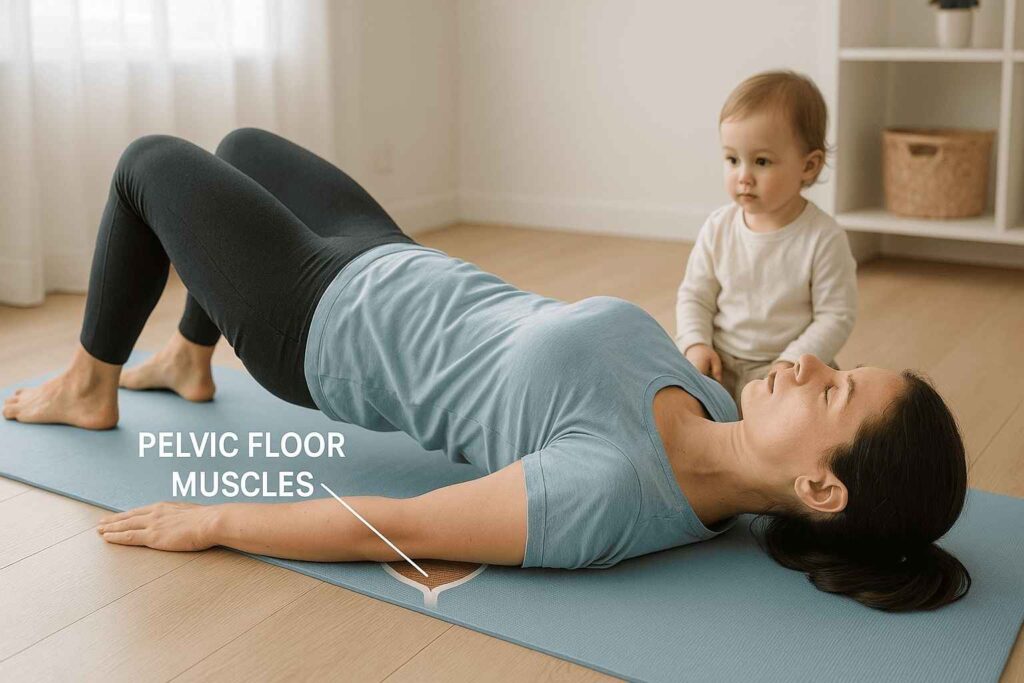Introduction
Expecting mothers often seek holistic approaches to support their journey through pregnancy, motherhood & Prenatal yoga. One of the most beneficial practices is prenatal yoga, which promotes physical and mental well-being during pregnancy while preparing mothers for labor and postpartum recovery for .

Prenatal and postnatal yoga serve as essential practices for mothers, highlighting their importance in promoting both physical and mental well-being during and after pregnancy. Engaging in these practices is not just about maintaining fitness; it’s about finding balance, self-care, and community support during the transformative stages of motherhood. By integrating mindfulness, movement, and breathing techniques, yoga offers a comprehensive tool to navigate the joys and challenges of motherhood while enhancing the connection with the growing baby.
These holistic practices encourage relaxation, alleviate stress, and improve mood, making them vital components of a positive pregnancy experience and a smoother transition into motherhood.
Benefits of Prenatal Yoga
Prenatal yoga is more than just a workout; it’s a holistic approach to enhancing the well-being of expecting mothers. By emphasizing gentle movement and mindfulness, it provides myriad benefits throughout pregnancy.

Improves Sleep
Practicing prenatal yoga helps enhance sleep quality during pregnancy. The combination of physical activity and relaxation techniques promotes a better ability to rest, which is often challenging for many pregnant women.

Reduces Stress and Anxiety
Engaging in prenatal yoga can significantly lower stress and anxiety levels. The practice actively engages the nervous system to block cortisol, often referred to as the stress hormone, leading to a calmer state of mind.
Increases Strength, Flexibility, and Endurance
The development of key muscle groups is essential for childbirth, and prenatal yoga plays a vital role in this. By increasing strength and flexibility, it prepares the body for labor and enhances endurance during the birthing process.

Decreases Common Pregnancy Discomforts
Regular practice of prenatal yoga has been shown to alleviate various common pregnancy discomforts. Issues such as lower back pain, nausea, headaches, and shortness of breath can be lessened through the gentle movements and breathing exercises associated with yoga.
Better Labor and Delivery Outcomes
Women who practice prenatal yoga may experience a more positive delivery experience. The techniques learned can lead to shorter labor times and reduced perception of pain, contributing to a more manageable childbirth experience.
Improves Maternal Mental Health
Prenatal yoga significantly impacts mental health, leading to notable decreases in depression and anxiety levels. The integrated practices of movement, meditation, and relaxation foster a balanced emotional state, contributing to the overall well-being of the mother.
These benefits highlight the importance of incorporating prenatal yoga into a pregnant woman’s routine for both physical and mental health enhancements.

Benefits of Postnatal Yoga
Postnatal yoga offers multiple advantages for new mothers, addressing both mental and physical well-being in the postpartum phase.
Reduced Symptoms of Postpartum Depression
Postnatal yoga can effectively alleviate symptoms of postpartum depression, which may arise from weeks to a year after childbirth. Engaging in yoga helps mothers manage their emotional health during this demanding period.
Enhanced Mood and Emotional Well-Being
Practicing yoga postnatally contributes to decreased anxiety and irritability. It promotes relaxation and calmness, providing essential emotional support as new mothers navigate the challenges of motherhood.

Physical Recovery
Gentle movements in postnatal yoga aid in regaining physical strength after childbirth. This practice helps alleviate discomfort associated with the physical changes that occur during and after pregnancy, facilitating a smoother recovery process.
Pelvic Floor Strengthening
Dedicated exercises during postnatal yoga improve bladder control and enhance pelvic floor health. Strengthening the pelvic floor is vital for many mothers as they recover from childbirth and work on regaining overall bodily function.
Increased Energy Levels
Postnatal yoga plays a role in combating fatigue by helping restore energy levels in new mothers. The physical activity, coupled with breathing techniques and meditation, can rejuvenate mothers, enabling them to better manage their daily responsibilities.

Facilitated Bonding with Babies
An essential aspect of postnatal yoga is the opportunity for mothers to practice while engaging with their infants. This not only fosters a unique bonding experience but also allows mothers to incorporate their babies into their wellness routines, creating a nurturing environment conducive to emotional connection.
Holistic Practices for New Mothers
Postpartum recovery is a vital time for new mothers as they transition to motherhood. Holistic practices play a significant role in supporting this journey through physical, emotional, and nutritional well-being.
Postpartum Nutrition
Eating well is crucial for recovery after childbirth. New mothers should focus on key nutrients:
- Leafy Greens: These are packed with vitamins and minerals essential for postpartum recovery.
- Fatty Fish: High in omega-3 fatty acids, which are beneficial for brain health.
- Nuts and Seeds: They provide healthy fats and protein, fostering healing and energy replenishment.

Specific vitamins also play a pivotal role in recovery. Vitamin D and calcium are important for bone health, while omega-3 fatty acids and iron support various bodily functions and energy levels.
Gentle Movement
Engaging in gentle movement is beneficial for new mothers. Activities such as walking and light yoga improve circulation and can help alleviate body aches. These forms of exercise are not only accessible but also effective in enhancing mood and physical wellness during postpartum recovery.
Emotional Support
Emotional well-being is equally important. Mindfulness practices, including meditation and deep breathing exercises, can significantly improve mental health. Joining support groups provides a network of shared experiences, fostering connections with other mothers and reducing feelings of isolation.
Hydration
Staying hydrated is crucial for new mothers, particularly if they are breastfeeding. Drinking enough water helps maintain energy levels and supports overall health. Incorporating water-rich foods, such as fruits and vegetables, can also assist in meeting hydration needs.
Rest and Self-Care
Rest is essential for recovery after childbirth. Prioritizing sleep can significantly impact a new mother’s physical and mental health. Establishing a sleep routine, finding quiet moments throughout the day, and practicing self-care can greatly enhance well-being.
By integrating these holistic practices into their daily routines, new mothers can better support their recovery and navigate the complexities of early motherhood.
Yoga Poses for Prenatal Health
First Trimester Yoga Poses
During the first trimester, gentle yoga poses can help alleviate discomfort and promote relaxation. Here are three beneficial poses:
Head-to-Knee Forward Bend
- Benefits: This pose helps to improve circulation and calm the mind. It stretches the spine and hamstrings, which can alleviate lower back pain.
- Instructions: Sit with one leg extended while bringing the other foot against your inner thigh. Inhale and extend your arms overhead, then exhale while bending forward towards the extended leg.
- Modifications: If flexibility is limited, place a cushion or blanket under your bent knee for added support.
Wide-Angle Seated Forward Bend
- Benefits: This pose opens up the hips and stretches the legs, which can be beneficial during pregnancy.
- Instructions: Sit with your legs wide apart. Inhale and lift your arms, then hinge at the hips to forward bend, keeping your back straight.
- Modifications: Use props such as blocks or a bolster to support your upper body as you lean forward.
Cat-Cow Pose
- Benefits: This pose improves spinal flexibility and alignment, creating space in the pelvis which is crucial for birth.
- Instructions: Begin on all fours, inhaling to arch your back (cat) and exhaling to round your spine (cow). Repeat several times.
- Instructions: Ensure movements are slow and gentle to connect with your breath.
Second Trimester Yoga Poses
As the body continues to change, the following poses can help with comfort and strength during the second trimester:
Bound Angle Pose
- Benefits: This pose strengthens the pelvic floor, enhances flexibility in the hips, and opens up the groin.
- Instructions: Sit with your feet together, allowing the knees to drop outward. Use your hands to gently press your knees down.
- Modifications: Sit on a folded blanket if needed for comfort.
Child’s Pose
- Benefits: A restorative pose that relieves tension in the back, shoulders, and neck while promoting relaxation.
- Instructions: Kneel and sit back on your heels. Lower your torso to the ground with your arms extended in front.
- Modifications: Use a cushion under your torso or between your thighs for extra support.
Triangle Pose
- Benefits: This pose helps build strength and stability, particularly in the legs and core, while enhancing flexibility in the hips.
- Instructions: Stand with legs wide, extending arms. Lean over one leg, placing the hand on the leg while reaching the other arm up.
- Modifications: Adjust the depth of the stretch based on comfort and balance.
Third Trimester Yoga Poses
In the third trimester, yoga should primarily focus on relaxation and preparing the body for labor:
Warrior II
- Benefits: Builds strength in the legs and opens the hips while improving mental focus and endurance.
- Instructions: Stand with legs wide apart, turn one foot out, and bend the knee over the ankle while extending both arms.
- Modifications: Shorten the stance if balance is an issue.
Garland Pose
- Benefits: This squat enhances flexibility in the hips and strengthens the pelvic floor, aiding in labor.
- Instructions: Stand, then lower into a squat while keeping your feet flat on the ground and your chest lifted.
- Modifications: Use a yoga block for support if needed.
Easy Pose
- Benefits: This calming seated position promotes relaxation and aids in breathing exercises.
- Instructions: Sit cross-legged with your hands resting on your knees, focusing on deep breathing.
- Modifications: If sitting on the floor is uncomfortable, use a cushion for elevation.
Prioritize comfort and consult with a healthcare provider before starting any new exercise routines, especially during pregnancy.
Importance of Breathing in Prenatal Yoga
Understanding proper breathing techniques is essential for expectant mothers practicing prenatal yoga.
Understanding Prenatal Breathing Practices
Pranayama, a disciplined method of breathing, plays a vital role in controlling energy and promoting relaxation. It allows pregnant women to connect with their bodies and enhances their awareness of the changes occurring during pregnancy. By focusing on their breath, mothers can find tranquility amidst the physical and emotional challenges they may encounter. Pranayama techniques not only calm the mind but also prepare the body for the demands of labor and delivery.
Benefits of Yoga Breathing in Pregnancy
The benefits of incorporating yoga breathing techniques during pregnancy are significant. Effective breathing practices improve oxygen flow, which is crucial for both the mother and the developing baby. Increased oxygen intake can lead to enhanced energy levels and a more positive mood. Additionally, these techniques help reduce stress and anxiety, creating a more supportive environment for the mother and fetus. Moreover, consistent practice of breathing exercises prepares mothers for labor by teaching them how to manage pain through controlled breathing. This focus can ultimately lead to a more empowering birthing experience.

Safety Tips for Prenatal Yoga
Practicing prenatal yoga can be beneficial for both physical and mental well-being during pregnancy. However, it’s crucial to prioritize safety. Here are some essential tips to keep in mind.
Listen to Your Body
Pay close attention to your body’s signals. If you feel discomfort in any position, it’s important to stop immediately. This practice encourages you to honor your body and respect its limits, ensuring a safe yoga experience throughout your pregnancy.
Resting Position
After 16-20 weeks of pregnancy, it is advisable to lie on your left side while resting. This position can promote better blood circulation to your baby and relieve pressure from the uterus on the major blood vessels.
Twisting Techniques
Avoid closed twists during your yoga sessions. Instead, opt for open twists that allow for gentle stretching and movement without straining your abdomen. This modification keeps the practice safe for both you and your baby.
Avoid Overexertion
Moderation is key. Practice at a pace that feels comfortable for you, and remember to stay hydrated throughout your sessions. Overexertion can lead to unnecessary risk, so it’s essential to listen to your body and not push beyond your limits.
By following these safety tips, you can ensure a more enjoyable and secure prenatal yoga experience.
Finding a Suitable Yoga Instructor
Assessing Your Level and Goals
Before beginning your search for a yoga instructor, it’s essential to understand your own level and goals. Consider whether you are a beginner or if you have specific therapeutic needs that should be addressed in your practice. This self-assessment helps in finding an instructor whose expertise aligns with your yoga journey.
Researching Local Options
To find potential yoga instructors near you, leverage local listings and seek recommendations from friends or family members. Online platforms often provide reviews and ratings that can give you insights into various instructors’ teaching styles and reliability. This way, you can narrow down your options based on reputable feedback from others in your community.
Engaging with Instructors
Once you have shortlisted some instructors, attend trial classes to get a feel for their teaching styles and your comfort level with them. This engagement helps you gauge whether their approach aligns with your personal preferences and if you feel supported in your practice. It’s essential to ensure that the instructor’s philosophy resonates with your yoga goals.
By following these steps, you can more effectively find a suitable yoga instructor who meets your individual needs.

Common Challenges Faced in Prenatal/Postnatal Periods
Emotional Challenges
Expecting mothers often face emotional hurdles during the prenatal and postnatal periods. One significant emotional challenge is the “baby blues,” a condition that typically emerges within days following childbirth. Symptoms include mood swings, anxiety, and irritability, which can be distressing for new mothers. However, for some, these feelings may escalate into serious postpartum depression (PPD), characterized by persistent sadness, total disinterest in activities, and difficulties in bonding with the newborn. PPD affects approximately 10-15% of new mothers and requires appropriate support and interventions to manage effectively 1.
Common Postpartum Complications
After childbirth, various physical complications may arise that can impact a mother’s well-being. Cardiovascular diseases are notably prevalent, as the body undergoes significant changes during pregnancy and childbirth. Moreover, infections are a serious concern, requiring vigilant monitoring and prompt medical attention. Alongside these physical health issues, there is a profound need for emotional support. New mothers may feel overwhelmed and isolated; hence, communities and healthcare providers must take an active role in offering resources, counseling, and peer support to help them navigate through this challenging period 2.
Meditation Techniques for Expecting Mothers
Meditation can be profoundly beneficial for expecting mothers, offering them not only a way to relax but also tools to connect with their developing baby. Utilizing meditation techniques during pregnancy can significantly enhance emotional well-being and foster a positive mindset.
Benefits of Meditation During Pregnancy
Engaging in meditation during pregnancy provides several key benefits:
- Stress Reduction: One of the primary benefits is the ability to reduce stress levels. Chronic stress can negatively impact both the mother and the baby, making stress management crucial during this period 1.
- Emotional Regulation: Meditation helps in emotional regulation, allowing expecting mothers to navigate the ups and downs of pregnancy with greater ease and resilience 2.
Meditation Techniques
Some effective meditation techniques that expecting mothers can incorporate into their routine include:
- Deep Belly Breathing: This technique involves inhaling deeply through the nose, allowing the belly to expand, and then exhaling slowly. It helps in calming the mind and body while delivering oxygen to both mother and baby.
- Body Scan: The body scan technique promotes relaxation by having mothers focus sequentially on different parts of the body. This can help release any tension that builds up during pregnancy.
- Mindfulness: Practicing mindfulness enables mothers to stay present in the moment, reducing anxiety about the future. It encourages a deep connection with their baby and enhances overall well-being.
- Visualization Techniques: Visualizing a serene environment or the bond with the baby can evoke feelings of love and tranquility, promoting a positive mindset during pregnancy.
By incorporating these techniques into daily life, expecting mothers can improve their mental and emotional health, making their pregnancy experience more enjoyable and serene.
Stress Relief Techniques for New Mothers
Taking care of a newborn can be overwhelming, and it’s essential for new mothers to prioritize self-care and stress relief. Here are some techniques to help manage stress during this new chapter of life.
Unwind and Relax
Finding time to unwind is vital for mental health. New mothers should consciously set aside moments for relaxation, even amidst the busyness of caring for a baby. Simple practices such as deep breathing, meditation, or enjoying a warm bath can help reduce anxiety and contribute to overall well-being. By making relaxation a priority, mothers can recharge their energy levels and improve their mood.
Social Interactions
Connecting with other parents can significantly alleviate feelings of isolation. Sharing experiences, exchanging advice, and just having a conversation can provide emotional support and remind mothers that they are not alone in their challenges. Joining parent groups or engaging with friends and family can create a supportive network essential to navigating motherhood. Social interactions are a powerful tool in combating stress and enhancing emotional resilience.
Community Support for Postpartum Mothers
Understanding the challenges of new motherhood is crucial, and community support serves as an essential lifeline for postpartum mothers. This support not only helps mothers, but also fosters a healthier environment for both the mother and the baby. Studies show that community support can significantly reduce feelings of isolation and enhance maternal mental health, leading to improved outcomes for families 1.
Key Support Resources
A variety of organizations provide critical resources for postpartum mothers, ensuring they receive the support they need. Among these, Postpartum Support International (PSI) offers a wealth of information and resources tailored for new mothers dealing with postpartum depression and anxiety. They provide a helpline, online support groups, and education on mental health to help mothers navigate their experiences 2.
Additionally, the Substance Abuse and Mental Health Services Administration (SAMHSA) plays an important role in connecting mothers with mental health services. SAMHSA’s helpline can guide new mothers towards appropriate treatments and therapies to address their mental health needs. They focus on ensuring access to care and providing necessary information regarding mental health management 2.
Collectively, these resources help create a supportive community, allowing postpartum mothers to thrive during a challenging yet transformative period of their lives.

weed gummies international shipping discreetly worldwide